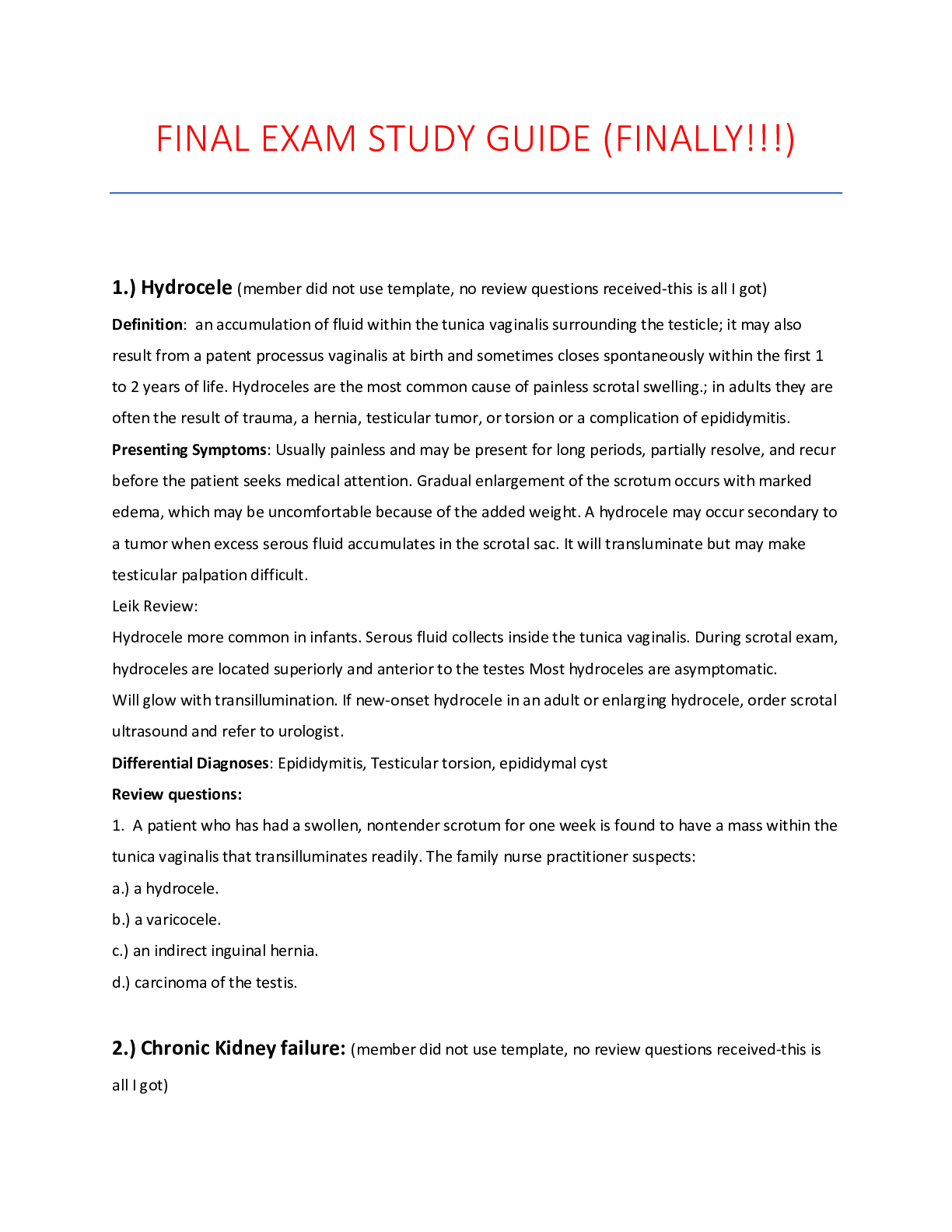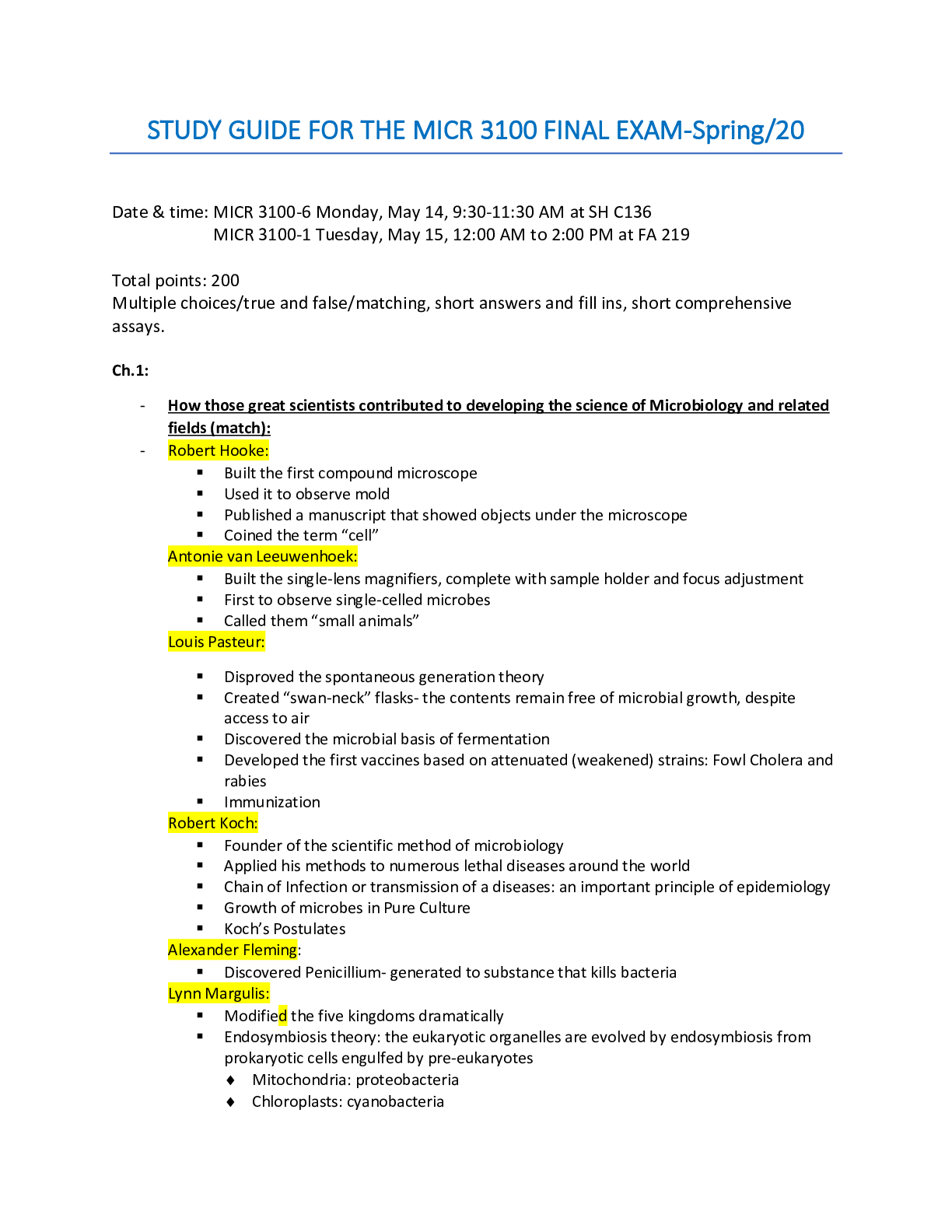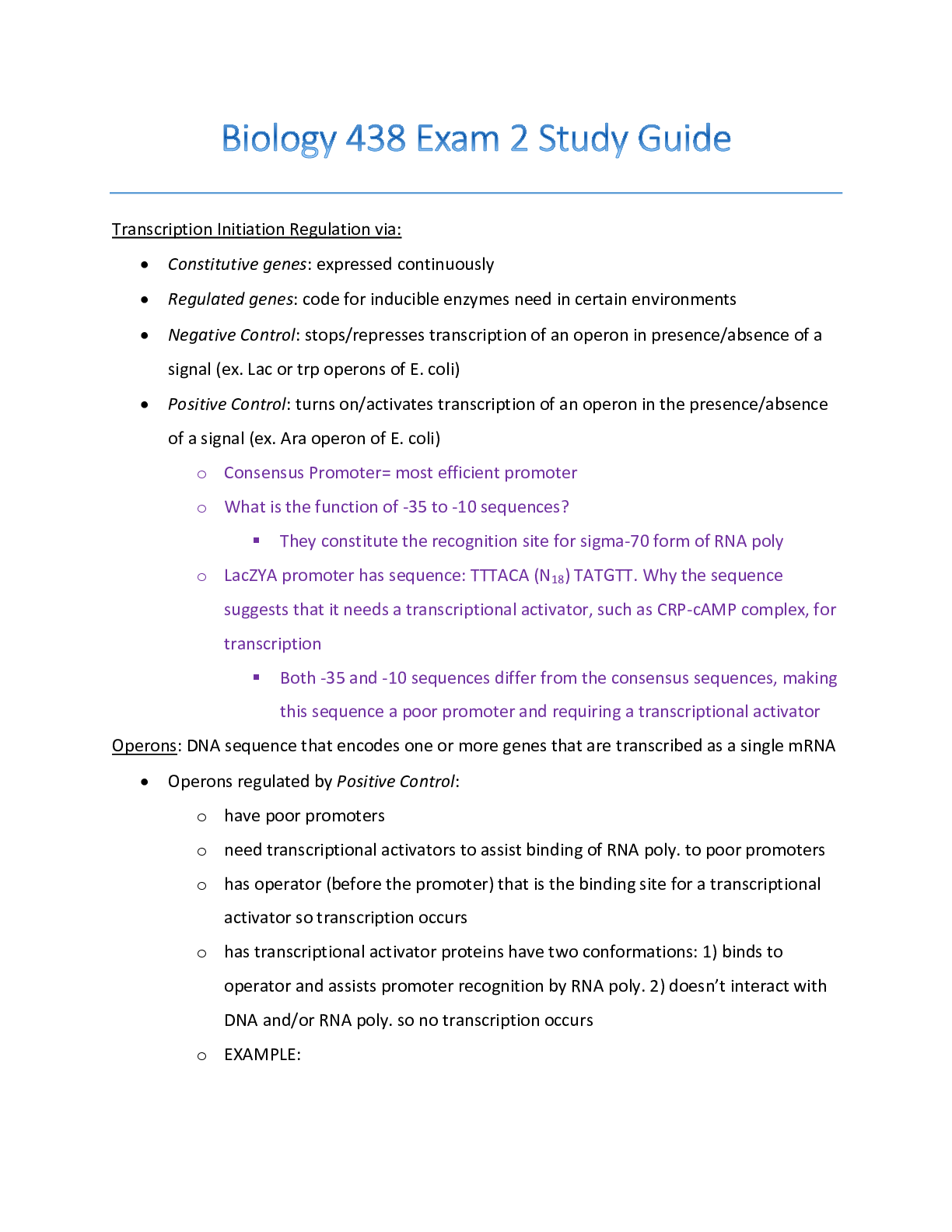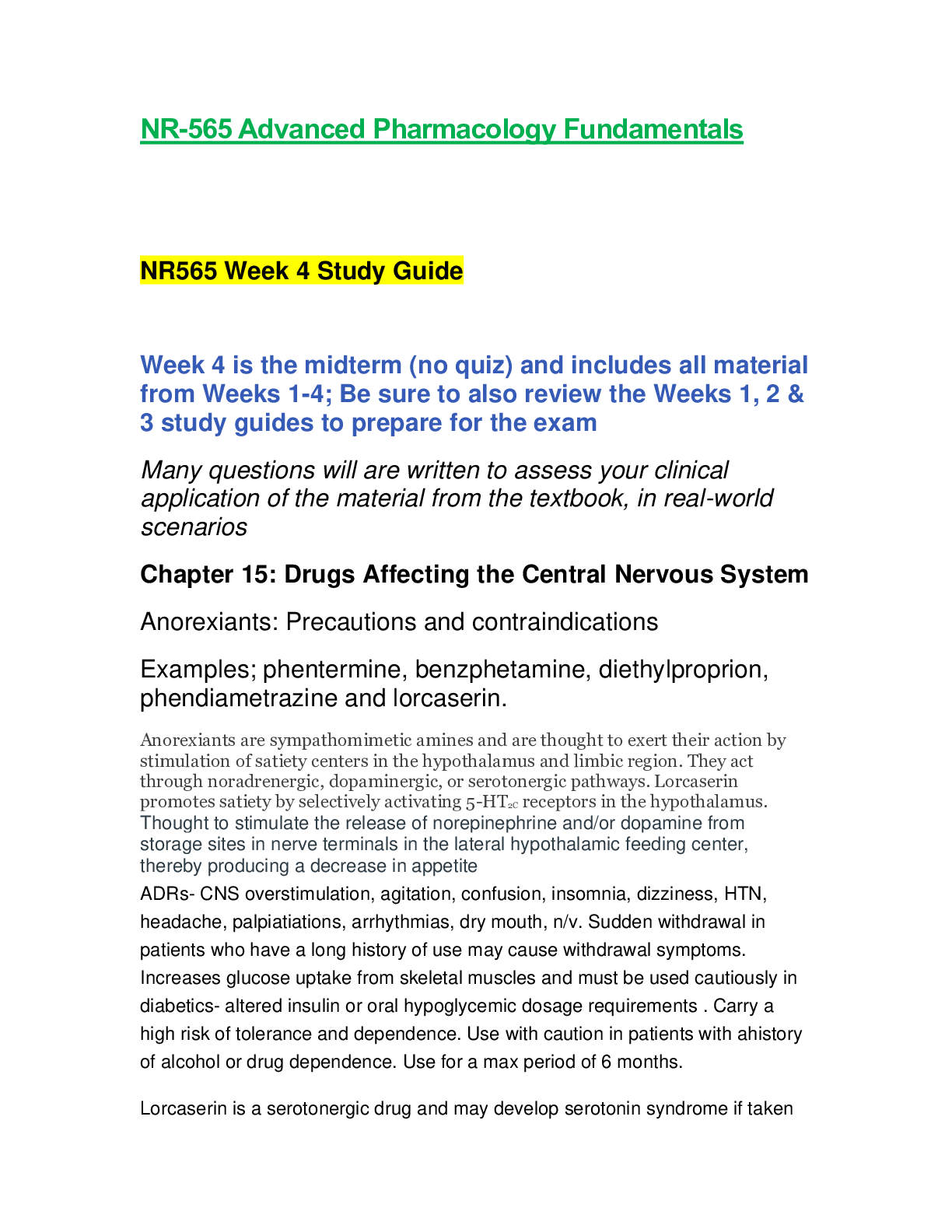*NURSING > STUDY GUIDE > NR 508 Advanced Pharmacology Week 2 TD and Quiz. (30 Pages of Discusssion, References and Quiz Conte (All)
NR 508 Advanced Pharmacology Week 2 TD and Quiz. (30 Pages of Discusssion, References and Quiz Content).
Document Content and Description Below
PART 1: (Ch 17, 18, 21, 24, 52, 53) Cynthia is a 65-year-old African American female who presents to the clinic for a check-up. Her last examination was ~5 years ago. She has no specific, significant... , or urgent complaint. She explains that her only issues are thirst, fatigue, and leg numbness and tingling, which is beginning to occur more often. You decide to do a physical exam, as well as draw labs and receive the following results: Social history: no smoking or alcohol consumption. Physical examination: GEN: well nourished, slightly obese female VS: BP 180/103 HR 73 RR 13 T 98.4 Weight 90 kg, Height 5’6” HEENT: PERRLA COR: RRR (regular rate & rhythm), NMRG (No murmur (valve), rub (friction/fluid around pericardium), gallop (valve)) CHEST: CTA NEURO: monofilament test shows decreased peripheral sensation EXT: normal • What are the major problems in this patient, and what diagnoses do these values indicate? • Additionally, what is your assessment and pharmacological plan for each of these problems including the medication, dose, and mechanism of action? Cynthia, a 55-year-old African American female, presents to the office with complaints of polydipsia, fatigue, and frequent leg numbness and tingling. Upon examination, Cynthia is found to have a BMI of 32, elevated blood pressure, and decreased peripheral sensation. Based on her physical exam, blood and urine lab work are ordered. Cynthia’s lab work and the physical exam reveal a number of issues including chronic kidney disease (CKD), hypertension (HTN) secondary to CKD, hyperthyroidism, diabetes mellitus type 2 (DM2) that is uncontrolled, diabetic peripheral neuropathy, hyperlipidemia, proteinuria, fatigue, polydipsia, and obesity. Cynthia’s major problems along with the pharmacological plan will be addressed below Chronic kidney disease, stage 3B (calculated GFR of 30mL/min/1.73 m2, Calculated creatinine clearance (CrCl) = 26-32 mL/min): Angiotensin-converting enzyme (ACE) inhibitors aid renal functions in hypertensive HTN, secondary to CKD: Weight loss via diet and exercise are a must. Approximately 80 to 85 percent of CKD patients also have HTN (Mann, 2016). Hyperthyroidism: This is a serious discussion that must be had with the patient, with the best options of treatment explained. DM2, uncontrolled: Weight loss via diet and exercise are a must. Hyperlipidemia, possibly secondary to uncontrolled DM2: Diabetic peripheral neuropathy, secondary to DM2: Proteinuria: Most likely from CKD, a complete 24-hour urine collection Bakris, G. (2017). Treatment of hypertension in patients with diabetes mellitus. UpToDate. Retrieved from https://www.uptodate.com/contents/treatment-of-hypertension-in-patients-with-diabetes-mellitus?source=see_link Feldman, E. (2016). Epidemiology and classification of diabetic neuropathy. UpToDate. Retrieved from https://www.uptodate.com/contents/epidemiology-and-classification-of-diabetic-neuropathy?source=search_result&search=diabetic neuropathy&selectedTitle=3~150 Feldman, E. & McCulloch, D. (2017). Treatment of diabetic neuropathy. UpToDate. Retrieved from https://www.uptodate.com/contents/treatment-of-diabetic-neuropathy?source=search_result&search=diabetic neuropathy&selectedTitle=1~150 Lexicomp Drug Interactions. (2017). UpToDate. Retrieved from https://www.uptodate.com/drug-interactions/?source=responsive_topic&topicId=8949&search=null - di-document Mann, J. (2016). Overview of hypertension in acute and chronic kidney disease. UpToDate. Retrieved from https://www.uptodate.com/contents/overview-of-hypertension-in-acute-and-chronic-kidney-disease?source=see_link Mann, J. & Hilgers, K. (2017). Renal effects of ACE inhibitors in hypertension. UpToDate. Retrieved from https://www.uptodate.com/contents/renal-effects-of-ace-inhibitors-in-hypertension?source=search_result&search=ace inhibitors&selectedTitle=7~150 McCulloch, D. (2017). Sulfonylureas and meglitinides in the treatment of diabetes mellitus. UpToDate. Retrieved from https://www.uptodate.com/contents/sulfonylureas-and-meglitinides-in-the-treatment-of-diabetes-mellitus?source=search_result&search=sulfonylureas&selectedTitle=1~137 McCulloch, D. (2017). Initial management of blood glucose in adults with type 2 diabetes mellitus. UpToDate. Retrieved from https://www.uptodate.com/contents/initial-management-of-blood-glucose-in-adults-with-type-2-diabetes-mellitus?source=search_result&search=newly diagnosed diabetes&selectedTitle=2~150 Rosenson, R. (2016). Treatment of lipids (including hypercholesterolemia) in secondary prevention. UpToDate. Retrieved from https://www.uptodate.com/contents/treatment-of-lipids-including-hypercholesterolemia-in-secondary-prevention?source=search_result&search=treatment of hyperlipidemia&selectedTitle=1~150 Ross, D. (2017). Radioiodine in the treatment of hyper thyroidism. UpToDate. Retrieved from https://www.uptodate.com/contents/radioiodine-in-the-treatment-of-hyperthyroidism?source=search_result&search=hyperthyroidism treatment&selectedTitle=4~150 Schneider, D., Sonderman, P., Jones, M., Ojomo, K., Chen, H., Jaume, J., . . . Sippel, R. (2014). Failure of radioactive iodine in the treatment of hyperthyroidism. Annals of Surgical Oncology, 21(13), 4174-4180. doi: http://dx.doi.org.proxy.chamberlain.edu:8080/10.1245/s10434-014-3858-4 https://search-proquest-com.proxy.chamberlain.edu:8443/docview/1619426974?OpenUrlRefId=info:xri/sid:wcdiscovery&accountid=147674 PART 2: Cynthia has been prescribed a plethora of medications. • How will you properly monitor each medication for efficacy and toxicity? • Are you concerned with any drug-drug interactions? • If so, what are they, and what is the mechanism of the interaction? DiNicolantonio, J. J. (2012). CoQ10 and L-carnitine for statin myalgia? Expert Review of Cardiovascular Therapy, 10(10), 1329-33. doi:http://dx.doi.org.proxy.chamberlain.edu:8080/10.1586/erc.12.92 Epocrates (2017). Epocrates, Inc. (Version 17.5.2) [Mobile application software]. Gabapentin (2017). Lexicomp. UpToDate. Retrieved from https://www.uptodate.com/contents/gabapentin-drug-information?source=search_result&search=gabapentin&selectedTitle=1~150 Lexicomp Drug Interactions. (2017). UpToDate. Retrieved from https://www.uptodate.com/drug-interactions/?source=responsive_topic&topicId=8949&search=null - di-document Repaglinide (2017). Lexicomp. UpToDate. Retrieved from https://www.uptodate.com/contents/repaglinide-drug-information?source=search_result&search=Repaglinide&selectedTitle=1~29 Thompson, P., Panza, G., Zaleski, A., & Taylor, B. (2016). Statin-associated side effects. Journal of the American College of Cardiology, 67(20), 2395-2410. doi: 10.1016/j.jacc.2016.02.071 Townsend, R. (2016). Major side effects of angiotensin-converting enzyme inhibitors and angiotensin II receptor blockers. UpToDate. Retrieved from https://www.uptodate.com/contents/major-side-effects-of-angiotensin-converting-enzyme-inhibitors-and-angiotensin-ii-receptor-blockers?source=search_result&search=ace inhibitors&selectedTitle=1~150 PART 3: Given Cynthia’s increased creatinine and renal deterioration, metformin is probably not optimal in this case. Therefore, upon subsequent visits, you decide to start her on a sulfonylurea. She reappears in your clinic fairly soon there after with complaints of shakiness, sweating, chills, clamminess, lightheadedness, and a moderately severe headache. • What is the diagnosis given these symptoms and the medications she is currently taking from Parts One and Two, and how would you proceed? • At this point, please also be sure to also provide an accurate summary of Cynthia’s medication plan. McCulloch, D. (2017). Sulfonylureas and meglitinides in the treatment of diabetes mellitus. UpToDate. Retrieved from https://www.uptodate.com/contents/sulfonylureas-and-meglitinides-in-the-treatment-of-diabetes-mellitus?source=search_result&search=Sulfonylureas&selectedTitle=1~137 Riddle, M. (2017). Modern sulfonylureas: Dangerous or wrongly accused? Diabetes Care, 40(5), 629-631. http://proxy.chamberlain.edu:8080/login?url=http://search.ebscohost.com/login.aspx?direct=true&db=mdc&AN=28428320&site=ehost-live Scott, L. (2012). Repaglinide. Drugs, 72(2), 249-272. doi:http://dx.doi.org.proxy.chamberlain.edu:8080/10.2165/11207600-000000000- file://localhost/00000 https/::search-proquest-com.proxy.chamberlain.edu/8443:docview:917215415%3FOpenUrlRefId=info/xri:sid/wcdiscovery&accountid=147674 Larson, A. (2016). Drugs and the liver: Metabolism and mechanisms of injury. UpToDate. Retrieved from https://www.uptodate.com/contents/drugs-and-the-liver-metabolism-and-mechanisms-of-injury?source=search_result&search=Cytochrome P450&selectedTitle=2~150 Lynch, T. & Price, A. (2007). The effect of cytochrome p450 metabolism on drug response, interactions, and adverse effects. American Family Physician, 76(3), 391-396. Retrieved from http://www.aafp.org/afp/2007/0801/p391.html ***Grapefruit juice blocks the hepatic action.**** Berns, J. & Glickman, J. (2017). Management of hyperglycemia in patients with type 2 diabetes and pre-dialysis chronic kidney disease or end-stage renal disease. UpToDate. Retrieved from https://www.uptodate.com/contents/management-of-hyperglycemia-in-patients-with-type-2-diabetes-and-pre-dialysis-chronic-kidney-disease-or-end-stage-renal-disease?source=search_result&search=metformin and renal disease&selectedTitle=2~150 Mann, J. & Hilgers, K. (2017). Renal effects of ACE inhibitors in hypertension. UpToDate. Retrieved from https://www.uptodate.com/contents/renal-effects-of-ace-inhibitors-in-hypertension?source=search_result&search=ace inhibitors&selectedTitle=7~150 QUIZ: A 40-year-old patient is in the clinic for a routine physical examination. The patient has a body mass index (BMI) of 26. The patient is active and walks a dog daily. A lipid profile reveals low-density lipoprotein (LDL) of 100 mg/dL, high-density lipoprotein (HDL) of 30 mg/dL, and triglycerides of 250 mg/dL. The primary care nurse practitioner (NP) should: The primary care NP sees a new patient who has diabetes and hypertension and has been taking a thiazide diuretic for 6 months. The patient’s blood pressure at the beginning of treatment was 150/95 mm Hg. The blood pressure today is 138/85 mm Hg. The NP should A 55-year-old woman has a history of myocardial infarction (MI). A lipid profile reveals LDL of 130 mg/dL, HDL of 35 mg/dL, and triglycerides 150 mg/dL. The woman is sedentary with a body mass index of 26. The woman asks the primary care NP about using a statin medication. The NP should A 55-year-old patient with no prior history of hypertension has a blood pressure greater than 140/90 on three separate occasions. The patient does not smoke, has a body mass index of 24, and exercises regularly. The patient has no known risk factors for cardiovascular disease. The primary care NP should: A primary care NP prescribes a nitroglycerin transdermal patch, 0.4 mg/hour release, for a patient with chronic stable angina. The NP should teach the patient to: A patient reports fatigue, weight loss, and dry skin. The primary care nurse practitioner (NP) orders thyroid function tests. The patient’s thyroid stimulating hormone (TSH) is 40 microunits/mL, and T4 is 0.1 ng/mL. The NP should refer the patient to an endocrinologist and prescribe: The primary care NP sees a new African-American patient who has blood pressure readings of 140/90 mm Hg, 130/85 mm Hg, and 142/80 mm Hg on three separate occasions. The NP learns that the patient has a family history of hypertension. The NP should: A child who has congenital hypothyroidism takes levothyroxine 75 mcg/day. The child weighs 15 kg. The primary care NP sees the child for a 3-year-old check-up. The NP should consult with a pediatric endocrinologist to discuss: A patient who has angina uses 0.4 mg of sublingual nitroglycerin for angina episodes. The patient brings a log of angina episodes to an annual physical examination. The primary care NP notes that the patient has experienced an increase in frequency of episodes in the past month but no increase in duration or severity of pain. The NP should: 12-year-old patient who is obese develops type 2 diabetes mellitus. The primary care NP should order: A patient who has stable angina is taking nitroglycerin and a β-blocker. The patient tells the primary care NP that the cardiologist is considering adding a calcium channel blocker. The NP should anticipate that the cardiologist will prescribe: An African-American patient who is obese has persistent blood pressure readings greater than 150/95 mm Hg despite treatment with a thiazide diuretic. The primary care NP should consider prescribing a(n): A patient who takes a calcium channel blocker is in the clinic for an annual physical examination. The cardiovascular examination is normal. As part of routine monitoring for this patient, the primary care NP should evaluate The primary care nurse practitioner (NP) sees a patient in the clinic who has a blood pressure of 130/85 mm Hg. The patient’s laboratory tests reveal high-density lipoprotein, 35 mg/dL; triglycerides, 120 mg/dL; and fasting plasma glucose, 100 mg/dL. The NP calculates a body mass index of 29. The patient has a positive family history for cardiovascular disease. The NP should The primary care NP is preparing to prescribe isosorbide dinitrate sustained release (Dilatrate SR) for a patient who has chronic, stable angina. The NP should recommend initial dosing of: A patient with Graves’ disease is taking methimazole. After 6 months of therapy, the primary care NP notes normal T3 and T4and elevated TSH. The NP should: A patient has been taking levothyroxine 100 mcg daily for several months. The patient comes to the clinic with complaints of insomnia and irritability. The primary care NP notes a heart rate of 92 beats per minute. The NP should: A patient who has type 2 diabetes mellitus takes metformin (Glucophage). The patient tells the primary care NP that he will have surgery in a few weeks. The NP should recommend A 45-year-old patient who has a positive family history but no personal history of coronary artery disease is seen by the primary care NP for a physical examination. The patient has a body mass index of 27 and a blood pressure of 130/78 mm Hg. Laboratory tests reveal low-density lipoprotein, 110 mg/dL; high-density lipoprotein, 70 mg/dL; and triglycerides, 120 mg/dL. The patient does not smoke but has a sedentary lifestyle. The NP should recommend A patient who has had a previous myocardial infarction has a blood pressure of 135/82 mm Hg. The patient’s body mass index is 28, and the patient has a fasting plasma glucose of 105 mg/dL. The primary care NP should prescribe: A patient who has a history of angina has sublingual nitroglycerin tablets to use as needed. The primary care nurse practitioner (NP) reviews this medication with the patient at the patient’s annual physical examination. Which statement by the patient indicates understanding of the medication? A patient has three consecutive blood pressure readings of 140/95 mm Hg. The patient’s body mass index is 24. A fasting plasma glucose is 100 mg/dL. Creatinine clearance and cholesterol tests are normal. The primary care NP should order: A patient who has diabetes is taking metformin 1000 mg daily. At a clinic visit, the patient reports having abdominal pain and nausea. The primary care NP notes a heart rate of 92 beats per minute. The NP should: A patient who has hyperlipidemia has been taking atorvastatin (Lipitor) 60 mg daily for 6 months. The patient’s initial lipid profile showed LDL of 180 mg/dL, HDL of 45 mg/dL, and triglycerides of 160 mg/dL. The primary care NP orders a lipid profile today that shows LDL of 105 mg/dL, HDL of 50 mg/dL, and triglycerides of 120 mg/dL. The patient reports muscle pain and weakness. The NP should: A patient who has angina is taking nitroglycerin and long-acting nifedipine. The primary care NP notes a persistent blood pressure of 90/60 mm Hg at several follow-up visits. The patient reports lightheadedness associated with standing up. The NP should consult with the patient’s cardiologist about changing the medication to: [Show More]
Last updated: 2 years ago
Preview 1 out of 30 pages

Buy this document to get the full access instantly
Instant Download Access after purchase
Buy NowInstant download
We Accept:

Reviews( 0 )
$9.50
Can't find what you want? Try our AI powered Search
Document information
Connected school, study & course
About the document
Uploaded On
Sep 01, 2020
Number of pages
30
Written in
Additional information
This document has been written for:
Uploaded
Sep 01, 2020
Downloads
0
Views
102




-3-168.png)




















